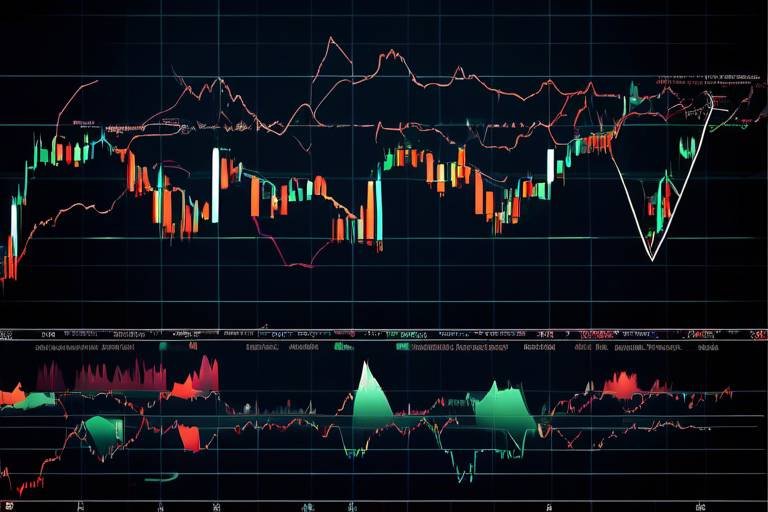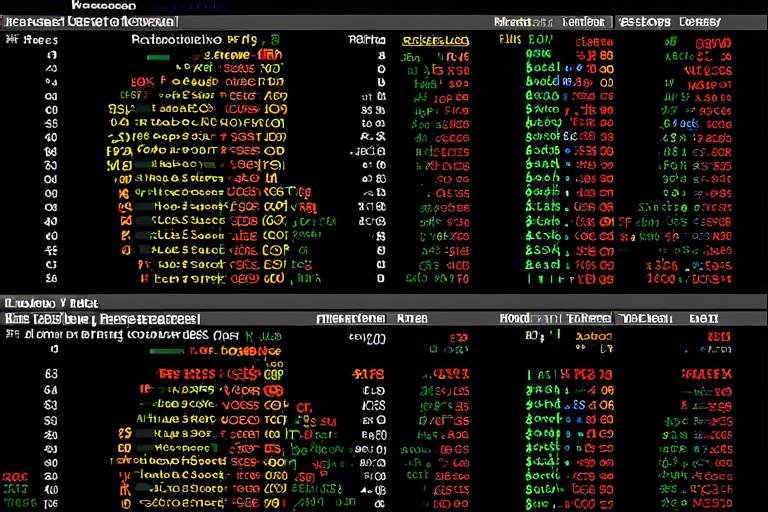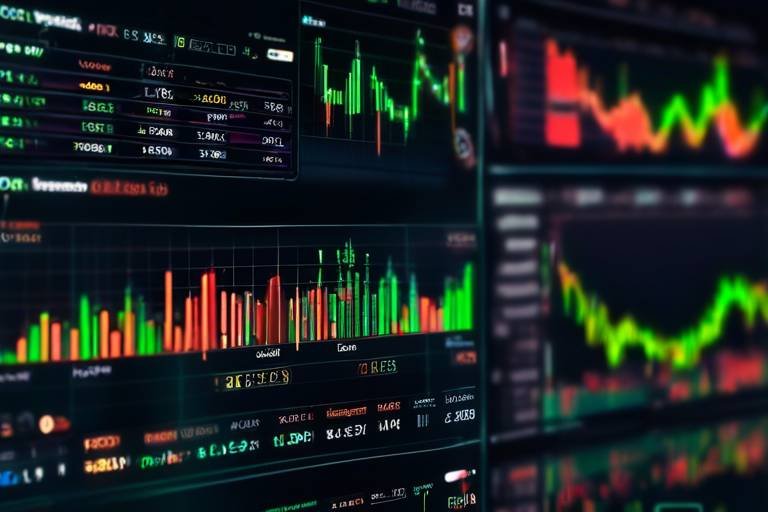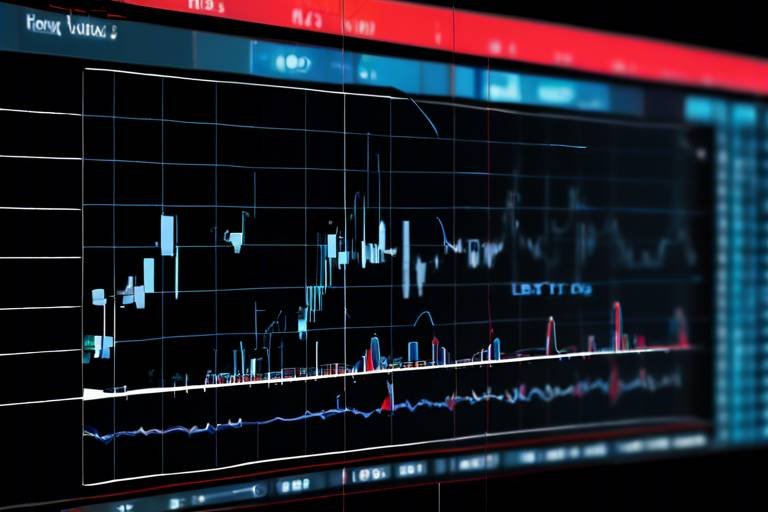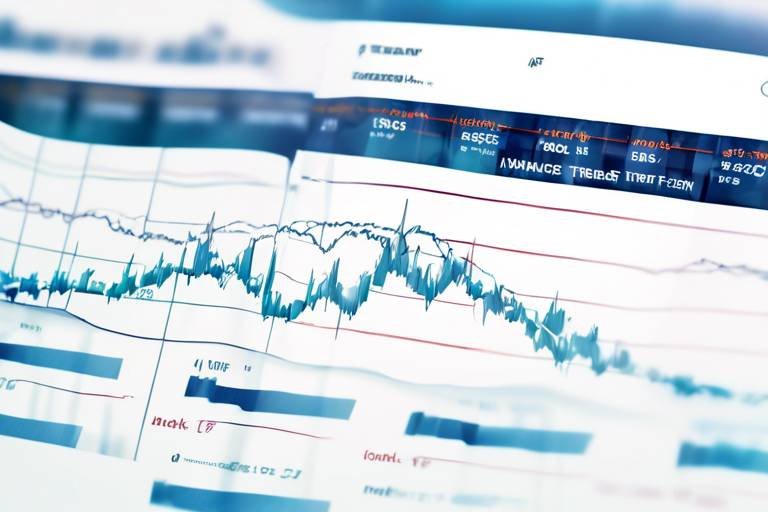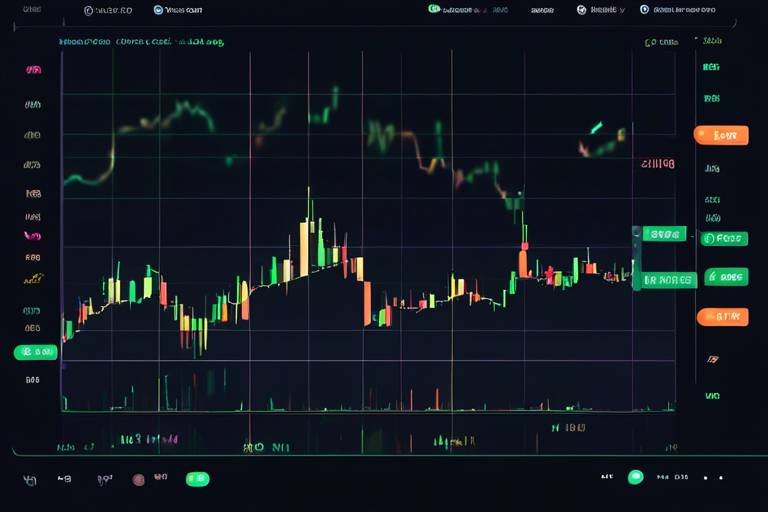The Basics of Algorithmic Trading in Cryptocurrency
Welcome to the exciting world of algorithmic trading in the cryptocurrency market! If you've ever wished you could automate your trading strategies, you're in the right place. Algorithmic trading is like having a smart assistant that works tirelessly to help you make the most of your trades. Imagine being able to execute trades at lightning speed, without the emotional rollercoaster that often accompanies manual trading. Sounds intriguing, right?
At its core, algorithmic trading involves using computer algorithms to execute trades based on pre-defined criteria. This means that instead of manually placing orders, traders can set up algorithms to automatically buy or sell cryptocurrencies when certain conditions are met. This not only saves time but also enhances the potential for profit. After all, in the fast-paced cryptocurrency market, timing is everything!
So, how does it work? The algorithms analyze market data, identify trading opportunities, and execute trades in real-time. This process is akin to having a highly skilled team of analysts working around the clock, ensuring that you never miss out on a profitable opportunity. But it's not just about speed; algorithmic trading also leverages complex mathematical models and data analysis to make informed decisions. Think of it as a chess game where your algorithm is always thinking several moves ahead.
As we delve deeper into this topic, we will explore various strategies employed in algorithmic trading, focusing on popular approaches like arbitrage and market making. Each of these strategies has its own nuances and applications, particularly in the volatile world of cryptocurrencies. For instance, arbitrage exploits price discrepancies between different exchanges, while market making provides liquidity to the market. Both strategies can be incredibly rewarding, but they also come with their own sets of risks and challenges.
To further enrich your understanding, let’s not forget about the tools that make algorithmic trading possible. Traders often rely on specialized software and platforms to create, test, and execute their algorithms. These tools can range from simple trading bots to sophisticated platforms that allow for backtesting and real-time data analysis. It’s like having a Swiss Army knife at your disposal, equipped with everything you need to navigate the unpredictable waters of cryptocurrency trading.
However, it’s essential to recognize that algorithmic trading isn’t without its risks. From technical failures to market volatility, there are several factors that traders must consider to safeguard their investments. In the upcoming sections, we will dive into these risks and explore how traders can effectively manage them. So, buckle up as we embark on this thrilling journey through the fundamentals of algorithmic trading in cryptocurrency!
- What is algorithmic trading? Algorithmic trading is the use of computer algorithms to automate the process of buying and selling assets like cryptocurrencies based on pre-defined criteria.
- What are the benefits of algorithmic trading? Benefits include increased trading efficiency, the ability to execute complex strategies, and data-driven decision-making.
- What are the risks associated with algorithmic trading? Risks include technical failures, market volatility, and the potential for significant losses if not managed properly.
- Can anyone engage in algorithmic trading? Yes, as long as you have access to the necessary tools and platforms, anyone can engage in algorithmic trading, though a solid understanding of the market is crucial.

Understanding Algorithmic Trading
Algorithmic trading is a revolutionary approach that leverages the power of computer algorithms to execute trades at optimal prices, often faster than any human trader could ever dream of. Imagine having a personal assistant that not only analyzes market data but also makes split-second decisions on your behalf. This is precisely what algorithmic trading offers, especially in the fast-paced world of cryptocurrency. By using predefined rules and conditions, these algorithms can analyze vast amounts of market data, identify trading opportunities, and execute trades with incredible precision.
At its core, algorithmic trading operates on a few key principles. First, it relies heavily on data analysis. Algorithms can process data from multiple sources, including price movements, trading volumes, and even social media sentiment. This ability to crunch numbers at lightning speed allows traders to spot trends and anomalies that might go unnoticed by the naked eye. For instance, an algorithm can monitor the price of Bitcoin across various exchanges and execute a trade the moment it identifies a significant price difference, potentially profiting from that discrepancy.
Moreover, algorithmic trading is not just about speed; it's also about consistency. Human emotions can often cloud judgment, leading to impulsive decisions that may not align with a trader's strategy. Algorithms, on the other hand, adhere strictly to their programming, executing trades based solely on data and predefined conditions. This removes the emotional aspect of trading, making it a more disciplined approach. However, it’s essential to remember that even the best algorithms can fail if they’re not designed with robust risk management strategies.
Another critical aspect of algorithmic trading is its flexibility. Traders can develop multiple algorithms tailored to different strategies, whether they are aiming for long-term investments or short-term gains. Some algorithms might focus on high-frequency trading, executing hundreds of trades per second, while others might employ a more relaxed approach, aiming for larger profits over a more extended period. This versatility allows traders to adapt their strategies based on market conditions and personal preferences.
In summary, understanding algorithmic trading in cryptocurrency is about grasping how technology can enhance trading strategies. It combines speed, accuracy, and emotional detachment, making it an attractive option for both novice and experienced traders. However, while the benefits are significant, it’s crucial for traders to continuously monitor their algorithms and adjust them as necessary to keep up with the ever-changing market landscape.

Key Strategies in Algorithmic Trading
When diving into the world of algorithmic trading, it’s essential to understand that there isn’t a one-size-fits-all approach. Instead, traders can harness a variety of strategies tailored to their unique goals and market conditions. Among the most prevalent strategies are arbitrage and market making, each offering distinct advantages and challenges.
Arbitrage is like a financial scavenger hunt where traders seek out price discrepancies across various exchanges. Imagine spotting a rare collectible at a garage sale for a fraction of its actual value and then flipping it for a profit at a nearby market. This is precisely what arbitrage traders do—they buy low on one platform and sell high on another. The thrill lies in the speed and precision required to capitalize on these fleeting opportunities. However, to excel in this strategy, traders must be equipped with the right tools and a keen eye for market movements.
On the other hand, market making is akin to being the life of the party, providing liquidity to the market by placing simultaneous buy and sell orders. Market makers help ensure that there’s always someone ready to trade, which keeps the market flowing smoothly. This strategy can be particularly lucrative, as market makers often earn a profit from the spread—the difference between the buying and selling price. However, it’s crucial to understand the risks involved, especially in a volatile market like cryptocurrency.
Now, let’s delve deeper into these strategies:
Arbitrage opportunities arise from the inefficiencies in the market. For instance, if Bitcoin is trading at $40,000 on Exchange A and $40,500 on Exchange B, a savvy trader can buy on Exchange A and sell on Exchange B, pocketing a $500 profit. However, timing is everything. Prices can change rapidly, and the window of opportunity may close in seconds. To effectively engage in arbitrage, traders often rely on sophisticated algorithms that can analyze multiple exchanges simultaneously.
There are several types of arbitrage strategies that traders can employ:
- Spatial Arbitrage: This involves buying an asset on one exchange and selling it on another where the price is higher.
- Triangular Arbitrage: This strategy exploits discrepancies in currency pairs within the same exchange, allowing traders to convert one currency to another and back to the original while making a profit.
To successfully engage in arbitrage, traders need access to specific tools and platforms that facilitate quick trades. Some popular tools include:
- Arbitrage Bots: Automated programs that scan multiple exchanges for price differences.
- Trading Platforms: User-friendly interfaces that allow traders to execute orders swiftly.
- Data Analytics Tools: Software that helps traders analyze market trends and identify potential arbitrage opportunities.
Market making is a strategy that requires a deep understanding of market dynamics. By placing buy and sell orders, market makers can earn profits from the spread while also providing much-needed liquidity. It’s like being a bartender at a busy bar; you need to keep the drinks flowing while ensuring that everyone gets served. Successful market makers have a strong grasp of market trends and are prepared to adjust their strategies as conditions change.
In summary, algorithmic trading encompasses a range of strategies, each with its own set of rules and risks. Whether you’re looking to capitalize on arbitrage opportunities or provide liquidity through market making, understanding these strategies is vital for any trader aiming to thrive in the fast-paced world of cryptocurrency.
Q1: What is algorithmic trading?
A1: Algorithmic trading is the use of computer algorithms to automate trading decisions and execute trades at optimal prices.
Q2: What are the main strategies in algorithmic trading?
A2: The main strategies include arbitrage and market making, each with unique methods and risk profiles.
Q3: How can I start algorithmic trading?
A3: To start algorithmic trading, you’ll need a reliable trading platform, a solid understanding of market strategies, and possibly some coding skills to develop or customize trading algorithms.

Arbitrage Opportunities
When it comes to the world of cryptocurrency trading, are like hidden treasures waiting to be discovered. Essentially, arbitrage involves taking advantage of price discrepancies for the same asset across different exchanges. Imagine this: you spot Bitcoin listed at $30,000 on Exchange A and $30,500 on Exchange B. By buying from the first and selling on the second, you pocket the difference. This simple yet effective strategy is what makes arbitrage so appealing to traders looking to maximize their profits.
However, finding these opportunities isn't as straightforward as it seems. The crypto market is incredibly dynamic, with prices changing rapidly. Traders need to be vigilant and equipped with the right tools to keep an eye on various exchanges simultaneously. Fortunately, there are several platforms and software solutions that can help automate this process, allowing traders to quickly identify and act on arbitrage opportunities. Some popular tools include arbitrage bots and real-time market trackers, which can scan multiple exchanges and alert traders when a profitable opportunity arises.
To illustrate the concept further, consider the following table that outlines some of the key factors involved in identifying arbitrage opportunities:
| Factor | Description |
|---|---|
| Price Discrepancy | The difference in price for the same asset on different exchanges. |
| Transaction Fees | Costs associated with executing trades, which can affect profitability. |
| Liquidity | The ease of buying/selling an asset without affecting its price. |
| Execution Speed | How quickly a trade can be executed, crucial for capitalizing on fleeting opportunities. |
It’s important to note that while arbitrage can be lucrative, timing and execution are everything. The crypto market's volatility means that a price gap can close within seconds. Therefore, successful arbitrage traders often rely on automated systems to ensure they can act fast enough. For instance, a well-programmed arbitrage bot can execute trades in milliseconds, significantly increasing the chances of profit.
Additionally, traders should be aware of the various types of arbitrage strategies they can employ. These include:
- Spatial Arbitrage: Buying and selling the same asset on different exchanges.
- Triangular Arbitrage: Exploiting price differences between three currencies in the same exchange.
Each strategy has its own set of benefits and risks, and understanding these nuances can aid traders in making informed decisions. In the fast-paced world of cryptocurrency, knowledge is power, and those who are prepared can turn arbitrage opportunities into significant profits.

Types of Arbitrage
When it comes to arbitrage in the cryptocurrency market, understanding the different types can significantly enhance your trading strategy. Essentially, arbitrage is the practice of taking advantage of price discrepancies across various exchanges, and there are several methods to do this effectively. Each type of arbitrage has its unique characteristics and applications, making it crucial for traders to know which method suits their needs best.
Let's dive into the two primary types of arbitrage that are particularly relevant in the world of cryptocurrency: spatial arbitrage and triangular arbitrage.
Spatial Arbitrage is the most straightforward type of arbitrage. It involves buying a cryptocurrency on one exchange where the price is lower and simultaneously selling it on another exchange where the price is higher. This method is often facilitated by the speed of algorithmic trading, allowing traders to capitalize on fleeting opportunities before the market corrects itself. For example, if Bitcoin is trading at $30,000 on Exchange A and $30,500 on Exchange B, a trader can buy from A and sell on B, pocketing a profit of $500 per Bitcoin before fees.
On the other hand, Triangular Arbitrage is a bit more complex and involves three different currencies within the same exchange. Here, traders exploit discrepancies in the exchange rates between three assets. For instance, if you start with Bitcoin, convert it to Ethereum, and then convert that Ethereum back to Bitcoin, you can potentially end up with more Bitcoin than you started with if the exchange rates are favorable. This type of arbitrage requires a keen understanding of currency pairs and a well-timed execution to be profitable.
| Type of Arbitrage | Description | Example |
|---|---|---|
| Spatial Arbitrage | Buying a cryptocurrency on one exchange and selling it on another. | Buy Bitcoin at $30,000 on Exchange A, sell at $30,500 on Exchange B. |
| Triangular Arbitrage | Exploiting price differences between three different currencies on the same exchange. | Convert Bitcoin to Ethereum, then Ethereum back to Bitcoin for profit. |
Both types of arbitrage require a solid understanding of the market and the ability to act quickly. Traders often use algorithms and trading bots to automate these processes, ensuring they can seize opportunities as they arise. However, it's important to note that while the potential for profit exists, so do risks, such as transaction fees and market fluctuations that can eat into profits.
In summary, whether you're diving into spatial or triangular arbitrage, having a clear strategy and the right tools at your disposal can make all the difference. The key is to remain vigilant and ready to act, as the cryptocurrency market is known for its rapid changes.
- What is arbitrage trading? Arbitrage trading is the practice of taking advantage of price differences in different markets to make a profit.
- Is arbitrage trading risk-free? No, while it can be profitable, there are risks involved, including market volatility and transaction fees.
- Do I need special tools for arbitrage trading? Yes, many traders use software and algorithms to automate the process and execute trades quickly.
- Can I use arbitrage strategies on any cryptocurrency? While it is possible, the effectiveness can vary based on the liquidity and volatility of the specific cryptocurrency.

Tools for Arbitrage
When diving into the world of arbitrage trading, having the right tools at your disposal is absolutely essential. Think of it as a chef needing the perfect knives to create a culinary masterpiece. In the realm of cryptocurrency, these tools help traders identify price discrepancies and execute trades swiftly, ensuring they capitalize on fleeting opportunities. Here are some of the key tools that can enhance your arbitrage trading experience:
- Trading Bots: These automated software programs can execute trades on your behalf based on predefined criteria. They are particularly useful for arbitrage as they can monitor multiple exchanges simultaneously, ensuring you never miss a profitable trade.
- Price Tracking Software: Tools like CoinMarketCap or CoinGecko provide real-time price data across various exchanges. This information is crucial for identifying arbitrage opportunities, as price discrepancies can be fleeting.
- API Access: Many exchanges offer Application Programming Interfaces (APIs) that allow traders to access their trading features programmatically. This means you can set up your own scripts to monitor prices and execute trades without manual intervention.
- Liquidity Aggregators: These platforms combine liquidity from multiple exchanges, allowing traders to find the best prices across the board. By using liquidity aggregators, you can ensure that your trades are executed at the most favorable rates.
In addition to these tools, it's wise to have a solid understanding of market trends and price movements. Many traders utilize advanced charting software that offers technical analysis features. This can help in predicting price movements and determining the best times to execute trades. Moreover, keeping an eye on news and market sentiment is critical, as external factors can influence cryptocurrency prices significantly.
Lastly, establishing a reliable internet connection and having a backup system in place can prevent losses caused by technical failures. Remember, in the fast-paced world of arbitrage trading, every second counts, and being prepared can make all the difference. With these tools and a strategic mindset, you can navigate the exciting yet volatile waters of cryptocurrency arbitrage trading effectively.
What is arbitrage in cryptocurrency trading?
Arbitrage in cryptocurrency trading refers to the practice of buying a cryptocurrency at a lower price on one exchange and simultaneously selling it at a higher price on another exchange to profit from the price difference.
Do I need programming skills to use trading bots?
While programming skills can enhance your ability to customize trading bots, many platforms offer user-friendly interfaces that allow you to set up and deploy bots without any coding knowledge.
How can I identify arbitrage opportunities?
You can identify arbitrage opportunities by using price tracking software to monitor prices across different exchanges. Additionally, employing trading bots can automate this process for you.
Are there risks associated with arbitrage trading?
Yes, arbitrage trading does carry risks, such as market volatility, transaction fees, and execution delays. It is crucial to have a solid risk management strategy in place.

Market Making Explained
Market making is a crucial component of the cryptocurrency trading ecosystem. Essentially, it involves providing liquidity to the market by placing both buy and sell orders. Think of market makers as the backbone of trading; they ensure that there’s always someone willing to buy or sell a cryptocurrency, which helps keep the market fluid and efficient. Without market makers, traders might find it challenging to execute their trades promptly, leading to larger price swings and increased volatility.
When a market maker places orders, they typically do so at different price levels to create a spread. This spread is the difference between the buying price (bid) and the selling price (ask). By continuously adjusting their orders, market makers can profit from the spread while also facilitating smoother transactions for other traders. This process is akin to a chef preparing multiple dishes simultaneously, ensuring that every order is filled promptly while managing the kitchen's workflow efficiently.
One of the fascinating aspects of market making in cryptocurrency is the use of algorithms. Many market makers employ sophisticated algorithms to analyze market conditions, predict price movements, and adjust their orders in real-time. This technology allows them to react quickly to changes in the market, which is vital in the fast-paced world of cryptocurrencies. Without these algorithms, market makers would struggle to keep up with the rapid price fluctuations that characterize this sector.
Moreover, market making is not just about making profits; it also plays a significant role in price stabilization. By providing liquidity, market makers help to reduce the impact of large trades on the market price. For example, if a trader decides to sell a large amount of a cryptocurrency, the presence of a market maker can absorb some of that selling pressure, preventing a drastic drop in price. This function is critical in maintaining investor confidence and the overall health of the market.
In summary, market making is a vital practice in cryptocurrency trading that ensures liquidity and stability. It involves placing buy and sell orders to facilitate trades while profiting from the spread. With the aid of algorithms, market makers can navigate the volatile waters of cryptocurrency with agility, ultimately benefiting the entire trading community.
- What is the primary role of a market maker? Market makers provide liquidity to the market by placing both buy and sell orders, ensuring that trades can be executed quickly and efficiently.
- How do market makers profit? They profit from the spread between the buying price and the selling price of cryptocurrencies.
- Are market makers essential for cryptocurrency trading? Yes, they play a crucial role in maintaining market liquidity and stability, which benefits all traders.
- Can anyone become a market maker? While technically anyone can act as a market maker, it typically requires significant capital and advanced trading strategies to be effective.

Risks Associated with Algorithmic Trading
While algorithmic trading can be a game-changer for many traders, it's essential to recognize that it doesn't come without its own set of risks. Just like a roller coaster ride, the thrill of potential profits is often accompanied by the reality of sudden drops. Traders need to be aware of the pitfalls that can arise when relying on automated systems to execute their strategies. In this section, we will explore some of the most significant risks associated with algorithmic trading, ensuring that you are well-informed before diving into this exciting yet volatile world.
One of the most pressing risks is technical failures. Imagine your trading algorithm is running smoothly, and suddenly, your system experiences an outage or a software bug. This could lead to missed opportunities or, worse yet, significant financial losses. It's crucial for traders to have robust systems in place and to develop contingency plans that can be activated in case of unforeseen technical issues. Regular maintenance and testing of algorithms can help mitigate these risks, but they can never be entirely eliminated.
Another critical aspect to consider is the inherent market volatility in the cryptocurrency space. Unlike traditional markets, cryptocurrencies are notoriously unpredictable, with prices that can swing dramatically in a matter of minutes. This volatility can wreak havoc on algorithmic trading strategies, especially those that rely on historical data to forecast future movements. Traders must be prepared for sudden market shifts that could render their algorithms ineffective. Implementing risk management strategies is essential to navigate these turbulent waters. For instance, setting stop-loss orders can help limit potential losses during extreme market fluctuations.
Furthermore, the reliance on data quality is paramount. Algorithmic trading systems depend heavily on accurate and timely data to make informed decisions. If the data feeds are compromised or delayed, it can lead to poor trading outcomes. Traders must ensure that they are using reputable sources for their data and continuously monitor the integrity of these feeds. The adage "garbage in, garbage out" rings particularly true in this context, as the quality of input data directly impacts the performance of the trading algorithms.
Lastly, there's the potential for market manipulation. In an environment as decentralized and less regulated as cryptocurrency trading, malicious actors can exploit algorithmic trading systems. This manipulation can take the form of "pump and dump" schemes or spoofing, where traders place large orders to create a false sense of market activity. Algorithmic traders need to be vigilant and incorporate safeguards to detect and respond to suspicious market behavior.
In summary, while algorithmic trading offers numerous advantages, it is not without its risks. Understanding these risks—ranging from technical failures and market volatility to data quality and market manipulation—is crucial for anyone looking to automate their trading strategies. By being aware of these potential pitfalls, traders can take proactive steps to protect themselves and enhance their trading experiences.
- What is algorithmic trading? Algorithmic trading involves using computer algorithms to execute trades automatically based on predetermined criteria.
- What are the main risks of algorithmic trading? Key risks include technical failures, market volatility, data quality issues, and market manipulation.
- How can I mitigate risks in algorithmic trading? Implement robust systems, conduct regular maintenance, utilize risk management strategies, and ensure high-quality data sources.
- Is algorithmic trading suitable for everyone? While it can be beneficial, it requires a good understanding of both trading and technology, making it more suitable for experienced traders.

Technical Failures
When diving into the world of algorithmic trading, one cannot overlook the shadowy specter of . These failures can manifest in various ways, leading to significant financial repercussions. Imagine you're in the heat of a trading frenzy, your algorithm is poised to capitalize on a fleeting opportunity, and suddenly your system crashes. It's like being on a rollercoaster that suddenly halts mid-ride—frustrating and potentially disastrous!
Technical failures in algorithmic trading can stem from several sources. For instance, system outages can occur due to server malfunctions or network issues. When a trader relies on automated systems to execute trades, any interruption can lead to missed opportunities or, worse, unintended trades. Furthermore, software bugs can also play a role. A minor glitch in the algorithm could cause it to execute trades at unfavorable prices, leading to losses that could have been avoided.
To mitigate the risks associated with these technical failures, traders should prioritize the robustness of their trading systems. Here are some essential strategies:
- Regular Maintenance: Just like a car needs regular servicing, trading algorithms require frequent updates and maintenance to ensure they function smoothly.
- Redundancy Systems: Implementing backup systems can help safeguard against unexpected outages. Think of it as having a spare tire in your trunk—always good to have just in case!
- Thorough Testing: Before deploying an algorithm into live trading, it should undergo rigorous testing in simulated environments to identify potential issues.
Additionally, having a well-defined contingency plan is crucial. Traders should be prepared with protocols to follow in the event of a technical failure. This could include having manual trading options available or setting predefined stop-loss orders to minimize losses. A contingency plan acts like a safety net, providing peace of mind amidst the unpredictable nature of cryptocurrency markets.
In conclusion, while the allure of algorithmic trading is undeniable, it is essential to navigate the landscape with caution. Understanding the potential for technical failures and implementing strategies to mitigate these risks can make a significant difference in a trader's success. After all, in the fast-paced world of cryptocurrency, being prepared can be the difference between a profitable trade and a costly mistake.
- What are the common causes of technical failures in algorithmic trading?
Common causes include server outages, network issues, and software bugs that can disrupt the execution of trades.
- How can traders prepare for technical failures?
Traders can prepare by maintaining their systems regularly, implementing redundancy systems, and having a contingency plan in place.
- What is the importance of testing algorithms?
Thorough testing helps identify potential issues before deploying algorithms in live trading, reducing the risk of technical failures.

Market Volatility
When it comes to the world of cryptocurrency trading, one word that often comes up is volatility. This term refers to the rapid and significant price fluctuations that can occur in the market. Unlike traditional markets, where price changes may happen gradually, the cryptocurrency market can experience wild swings in a matter of minutes. Imagine riding a roller coaster—sometimes you're soaring high, and other times you feel like you're plummeting down. This unpredictability can be both thrilling and terrifying for traders.
So, why does this volatility matter for algorithmic trading? Well, algorithms are designed to operate based on specific parameters and data inputs. However, when the market suddenly shifts, these algorithms might not react as intended, leading to unexpected losses. For instance, if an algorithm is programmed to execute a buy order when the price drops below a certain threshold, a sudden spike in volatility could cause the order to be executed at a much higher price than anticipated. This is where understanding market dynamics becomes crucial.
Moreover, the impact of news events can amplify this volatility. For example, a major announcement regarding regulatory changes or technological advancements can send prices soaring or crashing. Traders using algorithms must be aware of these events and how they can influence market behavior. Algorithms can be programmed to monitor news feeds and social media sentiment, but they still require human oversight to interpret the context of these events accurately.
To navigate this turbulent landscape, traders often employ various risk management strategies. Here are a few common approaches:
- Stop-Loss Orders: These are pre-set orders to sell a cryptocurrency when it reaches a certain price, helping to limit potential losses.
- Diversification: Spreading investments across different cryptocurrencies can reduce the risk associated with volatility in any single asset.
- Position Sizing: This involves determining the amount of capital to allocate to each trade based on the trader's risk tolerance.
Understanding and managing volatility is essential for anyone involved in algorithmic trading. Traders who can anticipate and react to market changes are more likely to succeed in this fast-paced environment. As the cryptocurrency market continues to evolve, staying informed and adaptable will be the key to thriving amidst the chaos.
Q1: What causes volatility in the cryptocurrency market?
A1: Volatility in the cryptocurrency market can be attributed to several factors, including market speculation, regulatory news, technological developments, and the relatively low market capitalization compared to traditional assets.
Q2: How can I manage risks associated with market volatility?
A2: Traders can manage risks through strategies like setting stop-loss orders, diversifying their portfolios, and adjusting position sizes based on risk tolerance.
Q3: Can algorithms effectively handle market volatility?
A3: While algorithms can be programmed to react to market changes, they require constant monitoring and adjustments to adapt to sudden volatility effectively.

Benefits of Algorithmic Trading
Algorithmic trading has revolutionized the way traders interact with the cryptocurrency market, offering a plethora of advantages that traditional trading methods simply can't match. One of the most significant benefits is the speed at which trades can be executed. Automated trading systems can process vast amounts of data and execute orders in milliseconds, allowing traders to capitalize on fleeting market opportunities that would be impossible to catch manually. Imagine trying to catch a train that leaves in seconds; algorithmic trading is like having a jetpack that gets you there in an instant!
Moreover, algorithmic trading enhances efficiency. With algorithms handling the grunt work, traders can focus on developing strategies rather than getting bogged down in the minutiae of execution. This means they can implement more complex trading strategies without the stress of constant monitoring. For instance, a trader can set up a sophisticated arbitrage strategy that automatically buys low on one exchange and sells high on another, all while sipping coffee. This level of efficiency not only saves time but also increases the potential for profits.
Another compelling advantage of algorithmic trading is its reliance on data-driven decision making. Algorithms can analyze market conditions and historical data at a scale that human traders simply cannot match. This ability to process data quickly leads to informed trading decisions, reducing the emotional biases that can often cloud judgment. In the fast-paced world of cryptocurrency, where emotions can lead to hasty decisions, having a data-driven approach is like having a compass in a stormy sea.
Additionally, algorithmic trading can significantly reduce the impact of human error. Even the most seasoned traders can make mistakes, whether it's due to fatigue, stress, or simple oversight. By automating the trading process, these errors can be minimized, leading to a more consistent trading performance. After all, no one wants to accidentally hit the wrong button and sell their Bitcoin at a fraction of its value!
To summarize, the benefits of algorithmic trading can be encapsulated as follows:
- Speed: Executes trades within milliseconds.
- Efficiency: Allows traders to focus on strategy development.
- Data-Driven Decisions: Minimizes emotional biases in trading.
- Reduced Human Error: Automates processes to ensure consistency.
In conclusion, the advantages of algorithmic trading are numerous and multifaceted. As technology continues to advance, traders who harness these benefits will likely find themselves at a distinct advantage in the ever-evolving cryptocurrency landscape.
Q1: What is algorithmic trading?
A1: Algorithmic trading refers to the use of computer algorithms to automate trading decisions and execute trades in financial markets, including cryptocurrencies.
Q2: How does algorithmic trading improve efficiency?
A2: By automating the trading process, algorithmic trading allows traders to implement complex strategies without constant monitoring, leading to better use of time and resources.
Q3: Can algorithmic trading eliminate human error?
A3: While it can significantly reduce human error, it is essential to note that algorithmic trading is not foolproof. Traders must ensure their algorithms are well-tested and monitored.
Q4: What role does data play in algorithmic trading?
A4: Data is crucial in algorithmic trading as it informs trading decisions, allowing algorithms to analyze market conditions and execute trades based on historical trends and real-time information.

Increased Trading Efficiency
When it comes to trading in the fast-paced world of cryptocurrency, speed and efficiency are not just luxuries; they are necessities. Imagine trying to catch a bullet train while running on foot—it's nearly impossible! This is where algorithmic trading steps in, acting like a high-speed train that whisks you away to your destination faster than you could ever manage manually. By leveraging automated systems, traders can execute orders in a fraction of a second, allowing them to capitalize on fleeting market opportunities that human traders might miss.
One of the most significant advantages of algorithmic trading is its ability to process vast amounts of data and execute trades based on predefined criteria. This means that traders can set specific conditions—like price thresholds or volume levels—and let the algorithm handle the rest. For instance, if Bitcoin's price drops below a certain point, the algorithm can automatically purchase it, ensuring that the trader doesn’t miss out on a potential bargain. This level of automation not only saves time but also minimizes the emotional decision-making that often leads to poor trading choices.
Moreover, algorithmic trading can operate 24/7, which is particularly advantageous in the cryptocurrency market that never sleeps. Unlike traditional stock markets with set trading hours, cryptocurrencies are traded around the clock. By utilizing algorithms, traders can take advantage of price movements at any hour, even while they sleep. This capability creates an environment where opportunities are continuously monitored and acted upon without the need for constant human oversight.
To illustrate the efficiency of algorithmic trading, consider the following table that compares traditional trading methods with algorithmic trading in terms of speed, accuracy, and emotional influence:
| Aspect | Traditional Trading | Algorithmic Trading |
|---|---|---|
| Speed | Slower; depends on manual execution | Instantaneous; executes trades in milliseconds |
| Accuracy | Prone to human error | High precision; follows set parameters |
| Emotional Influence | Subject to emotions; can lead to impulsive decisions | Emotionless; strictly adheres to logic and data |
In summary, the increased trading efficiency offered by algorithmic trading is a game changer in the cryptocurrency market. By automating the trading process, traders can not only save time but also enhance their ability to make informed decisions based on data rather than emotions. As the landscape of trading continues to evolve, those who embrace these automated systems will likely find themselves at a significant advantage, much like a sprinter who has the best running shoes on the market.
- What is algorithmic trading? Algorithmic trading involves using computer algorithms to execute trades automatically based on predefined criteria.
- How does algorithmic trading improve efficiency? It allows for instantaneous execution of trades, reducing the time taken to respond to market changes.
- Can anyone use algorithmic trading? Yes, anyone can use algorithmic trading, but it requires knowledge of programming and trading strategies to set up effectively.
- What are the risks of algorithmic trading? Risks include technical failures, market volatility, and the potential for significant losses if algorithms are not properly designed.

Data-Driven Decision Making
In the fast-paced world of cryptocurrency trading, the ability to make informed decisions can often be the difference between profit and loss. This is where comes into play. By leveraging vast amounts of data, traders can refine their strategies and improve their chances of success. Think of it as having a treasure map in a vast ocean; without it, you’re just sailing blind, but with it, you can navigate the waves of volatility with confidence.
At the core of data-driven decision making is the analysis of historical data, market trends, and various indicators that can provide insights into future price movements. Traders often utilize sophisticated algorithms to process this data, enabling them to identify patterns that may not be immediately apparent to the naked eye. For instance, by analyzing price movements over time, traders can uncover correlations and trends that inform their trading strategies.
Moreover, the use of technical indicators plays a crucial role in this process. Indicators such as Moving Averages, Relative Strength Index (RSI), and Bollinger Bands help traders gauge market sentiment and potential price movements. Here’s a quick overview of some common technical indicators:
| Indicator | Purpose |
|---|---|
| Moving Average | To smooth out price data and identify trends over a specific period. |
| Relative Strength Index (RSI) | To measure the speed and change of price movements, indicating overbought or oversold conditions. |
| Bollinger Bands | To assess market volatility and identify potential price reversals. |
In addition to technical indicators, sentiment analysis has gained traction in the cryptocurrency space. By monitoring social media, news articles, and forums, traders can gauge the market's mood. Are people feeling bullish or bearish? This kind of qualitative data can be just as valuable as quantitative data when making trading decisions.
However, it’s essential to remember that data-driven decision making is not foolproof. The cryptocurrency market is notoriously volatile, and even the most sophisticated algorithms can falter in the face of unexpected events. Therefore, traders should always implement robust risk management strategies to protect their investments. This could mean setting stop-loss orders or diversifying their portfolio to spread risk.
Ultimately, the key to successful algorithmic trading lies in the ability to combine data analysis with sound trading principles. By making decisions based on data rather than emotions, traders can navigate the unpredictable waters of cryptocurrency trading with greater confidence and precision. So, as you embark on your trading journey, remember: in the world of algorithms and data, knowledge truly is power!
- What is algorithmic trading? - Algorithmic trading refers to the use of computer algorithms to execute trades based on predefined criteria.
- How does data-driven decision making improve trading outcomes? - It allows traders to make informed decisions based on historical data and market trends, reducing emotional bias.
- What are some common technical indicators used in trading? - Common indicators include Moving Averages, RSI, and Bollinger Bands.
- Is algorithmic trading suitable for beginners? - While it can be beneficial, beginners should familiarize themselves with trading principles and risk management before diving in.
Frequently Asked Questions
- What is algorithmic trading in cryptocurrency?
Algorithmic trading in cryptocurrency refers to the use of computer algorithms to automate the trading process. These algorithms analyze market conditions and execute trades at optimal prices, allowing traders to capitalize on market opportunities without needing to monitor the markets constantly.
- What are the main strategies used in algorithmic trading?
There are several key strategies in algorithmic trading, including arbitrage and market making. Arbitrage takes advantage of price differences between exchanges, while market making involves providing liquidity by placing buy and sell orders. Each strategy has its own set of rules and applications in the cryptocurrency market.
- How can I identify arbitrage opportunities?
Identifying arbitrage opportunities involves monitoring price discrepancies across different exchanges. Traders can use specialized tools and software that track prices in real-time, allowing them to quickly spot and act on these opportunities before they disappear.
- What tools are essential for successful arbitrage trading?
Successful arbitrage trading typically requires tools such as trading bots, price tracking software, and APIs that facilitate quick order execution. These tools help traders manage their trades efficiently and respond to market changes swiftly.
- What risks should I be aware of in algorithmic trading?
Algorithmic trading carries several risks, including technical failures, such as system outages and software bugs, as well as market volatility. Traders must have robust systems in place and develop contingency plans to mitigate these risks effectively.
- How does market volatility affect algorithmic trading?
Market volatility can significantly impact algorithmic trading strategies, as sudden price movements may lead to unexpected losses or missed opportunities. Traders need to implement risk management strategies to protect their investments during volatile market conditions.
- What are the benefits of using algorithmic trading?
Algorithmic trading offers numerous benefits, including increased trading efficiency, the ability to execute complex strategies quickly, and data-driven decision-making. These advantages can lead to improved trading outcomes compared to manual trading.
- Can algorithmic trading help me make better trading decisions?
Yes, algorithmic trading relies heavily on data analysis, enabling traders to make informed decisions based on market trends and historical data. This approach can lead to more effective trading strategies and better overall performance.









